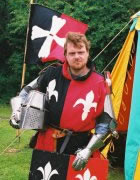 Name:
Name:
Sir Guy de Boissey
Armorial Bearing:
Sable and gules quarterly, four fleur-de-lis argent.
Profile:
Born in 1275 the only son of Sir Guilliame and Lady Isabelle de Boissey (Boissey a village in Normandy, about thirty miles south east of Caen). Sir Guilliame is known to have been elderly at the time of Guy's birth, from this we can presume that the young squire would have been largely self-taught in the fighting arts. This possible lack of ability may explain why, later, Sir Guy appears to have often used deception to rank in the tournament lists. His undoing, and the proof of his deceit, was the tournament held in the French town of Lisieux in 1295. The Marshall's suspicions were raised during the tilt when de Boissey received a lance strike which should certainly have taken him from his horse - when de Boissey's uncontrolled mount was eventually halted it was discovered that de Boissey was unconscious and that he had only remained in the saddle due to the fact that his armour was fastened to it. De Boissey, in disgrace, sailed for England soon after the contest. Surprisingly de Boissey made quite a name for himself in the English competitions, specialising in the foot combat, where he gained some notable victories (we can only assume by fair means).
By 1302 de Boissey had gathered some money, a small estate and a few dubious friends. The events of 1307 find de Boissey firmly on the side of the new king and his upstarts and against many of the long established English nobility. In 1308 we find him at the Dunstable tournament where we imagine that he was busily toadying to his new aristocratic friends, unfortunately, there are no records of final rankings in the contest.
All traces of Guy de Boissey in Britain disappear after 1308; he is not mentioned on the existing rolls for the battle of Bannockburn (although this does not prove his absence). There is some evidence, however, that he returned to France where he may have attended a tournament near Rheims in 1311. At the contest a "knight of Lisieux" carried a coat of arms that was simply too close to de Boissey's to be anyone else. The knight was unranked at this event but is later listed as "died with a broken back having been smote grievously". Interestingly this incident seems to have taken place, not at the tournament, but in a small village near the town of Camembert. Records indicate that the knight's horse bolted and that he struck the low branch of a tree. If this is true, and he was not wearing the body armour known as a "coat of plate", he was probably injured by the high back of his saddle. This could certainly have caused the serious damage described, (we also have to wonder whether he was bolted to it at the time). Records do not exist of Sir Guy's final resting place, as his grave is not apparent in either Boissey or Lisieux.
Within Tournée Sir Guy de Boissey is played by Chris Hughes, a re-enactor from Rossendale. Chris has been in re-enactment for over thirty years and has an avid interest in the weapon techniques of the period; his favourites are the long and the double-handed swords. "There's just so much mileage in Sir Guy" says Chris "he's foreign and a cheat, what more could you ask for? The only real problem I have with him is his accent…when I try to do French it usually starts out as a bad Dracula and quickly develops into a mixture of South African and Scandinavian, still, who knows what the language really sounded like back then?" (Chris has probably received at least one head blow too many.) "His demise is pure slapstick" he continues, "I bet he was drunk".
